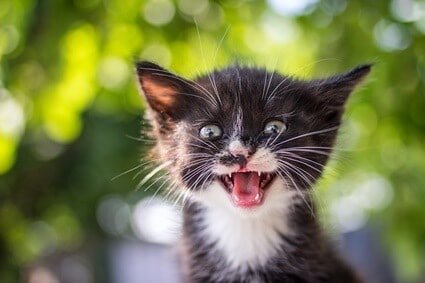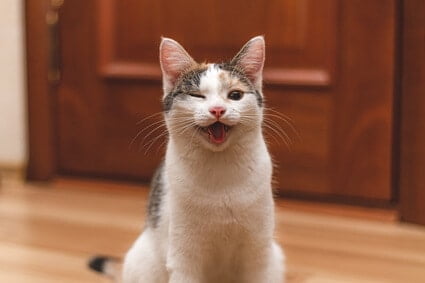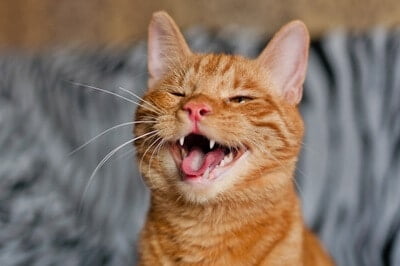Felines have deadpan, inexpressive facial features. This is why so many people misjudge the mood of a cat. Cats rely on subtle body language cues rather than grinning, laughing, and smiling to express feelings of happiness.
Cats can manipulate their faces into what a human would consider a smile. A cat can bare its teeth and curl its lips, but it’s not a grin. It’s more likely that the cat is grimacing in pain, preparing to bite, or investigating a new scent. Purring, kneading, and flicking of the tail are more reliable signs of a contented cat.
Smiling in happiness is not a part of a cat’s communication style, as that’s not how they evolved. Always remember this when approached by a cat that appears to be grinning at you.
Do Cats Smile When Happy?
Smiling to express contentment is not the repertoire of feline behavior. While cats can contort their mouths into a smile formation, this does not denote happiness. Assuming that a cat is smiling is anthropomorphizing a feline with human values.
In truth, cats are hardwired to avoid displaying any emotion. This is a survival mechanism handed down from wild descendants. If a cat is visibly content, another feline may attempt to steal its territory. While body language can reveal a cat’s mood, this is usually involuntary.
If a cat looks like it is grinning, it is experiencing a response to stimulation. You must understand whether your cat is denoting pleasure or pain. Either way, do this from a safe distance as the cat will not wish to interact.
Baring Teeth
When a cat bares its teeth at you, it can look like a wide grin. In many respects, the opposite is true. The cat is feeling threatened and defensive, so it is a warning gesture to back away. If you fail to comply, the cat will likely hiss and possibly attack.
It is also possible that the cat is experiencing dental pain. This will inspire the cat to hold its mouth in a unique position. It is attempting to alleviate discomfort without revealing weakness. Signs that a cat has sore teeth or gums include:
- Loss of appetite and refusal to drink water
- Foul breath
- Bleeding or discolored gums
- Pawing at the mouth
Almost all cats will experience dental problems at some point. Stave these issues off by brushing your cat’s teeth regularly. If your cat regularly displays its teeth, a dental clean will be required.
Curling Lips
A cat may also curl its top lip, creating a facial expression akin to a smile or grimace. It depends on the breed. Either way, it has the same meaning. The cat has detected a new scent that it is attempting to decipher.
This is referred to as the flehmen response. The cat is curling its lip and opening its mouth to provide access to the vomeronasal organ. This is located above the roof of a cat’s mouth, below the nasal cavity.
As explained by the Journal of Anatomy, this organ contains 44 different types of soft tissue. These react to the pheromones and hormones found in a new scent. The cat then assesses this aroma and commits it to memory.
A cat that displays the flehmen response will not harm you. Equally, it does not want to be disturbed.
Why Do Cats Smile When They Sleep?
If a cat smiles in its sleep, this suggests that the cat is enjoying its doze. As always, though, the cat is not actually smiling. Instead, it is reliving recent events.
As explained by Sleep, cats enter REM sleep as part of their slumbering routine. As a result, cats dream. Feline dreams are believed to be reenactments of the day’s activities. The cat’s brain is filtering through memories, deciding what to retain and what to discard.
As a result, the cat will react in its sleep as it would while awake. The cat is not smiling in contentment. It is repeating behavior displayed when previously presented with identical circumstances. This may involve baring teeth or curling the lip.

Do Cats Ever Laugh?
Like smiling, laughter is an alien concept to cats. Many cats have a mischievous sense of humor and enjoy fun. They do not respond to this through laughter, despite having sufficient biology to do so.
Cats will engage in behavior that makes humans laugh. Cats pick up on human facial expressions and reactions. This is why some cats appear content to act as domesticated court jesters.
This is simply a matter of association. If your cat does something that makes you happy, you’ll likely provide it with attention or treats. The cat will promptly make this link and repeat the behavior. The cat is not laughing with you.
Do Cats Laugh When Tickled?
When tickling a cat, you may observe body language akin to silent laughter. The cat’s body will heave as if it’s expressing amusement.
The cat is not laughing. It is merely responding, usually involuntarily, to the physical sensation of the tickling. Some cats enjoy this feeling, while others find it intrusive. Most cats purr if they enjoy tickling. This is the closest a cat comes to laughing in delight.
The rest of your cat’s body language holds the key to understanding this. Watch out for signs of agitation. These include hissing, seeking escape, and fidgeting. If your cat displays these behaviors, cease tickling and let the cat go.
Signs That a Cat is Happy
Smiling and laughing are universal signs of happiness. As cats are incapable of engaging in these behaviors, they may appear miserable. Thankfully, this is not the case, as cats show their happiness in other ways. They are just more subtle than outright grinning or laughing. Signs that your cat is in a great mood can be detected through body language.
Eyes
In many respects, cats smile with their eyes. Looking into the eyes of a cat can provide an insight into how it is feeling. As a rule, a cat with wide eyes is happy and contented.
This is especially likely if the cat suddenly widens its eyes and dilates its pupils. This suggests that something has pleased or excited the cat. This could be something you’re doing, or the cat may have detected prey to hunt.
Always observe your cat’s pupils while its eyes are wide open. The pupils should match the size of the eyes. If the pupils have contracted to a pin-prick size, the cat is angry.
Cats also, “kiss” with their eyes. This will involve the cat staring at you, then slowly blinking. This is arguably the greatest compliment a cat can pay you. Cat kisses are rare, reserved for when the cat is feeling particularly affectionate.
Half-closed eyes can also suggest happiness in a cat. This position denotes that a cat is completely relaxed. You may notice your cat’s eyes dropping to half-mast during petting. If so, the cat is enjoying the attention.
Ears
Feline ears are just as communicative as a cat’s eyes. A happy cat’s ears will be facing forward, slightly tilted to the side. The ears should also be still and static.
If a cat’s ears start to twitch, it is growing agitated. At this point, it’s best to leave the cat alone. If the ears are pushed back, step away from the cat as it may be planning to attack.
Tail
Keep an eye on your cat’s tail for signs of delight. While feline tails are less expressive than those of dogs, they still provide insight into moods.
If your cat’s tail points upward, it is in a happy and playful state of mind. If the tip of the tail begins to twitch, the cat is particularly pleased. If a cat wishes to share this moment with you, the tail will curve.

Vocal Cues
Purring is often seen as the sign of a happy and contented cat. In most cases, this is true. Purring is soothing to a cat, and as discussed, it’s the closest thing to feline laughter.
As explained by The Journal of the Acoustical Society of America, purring can also have a dark side. Some cats purr when frightened or in pain. This ties in with the soothing aspect of the feline purr.
If your cat is purring, look out for other body language cues. If the cat’s eyes, ears, and tail denote happiness, the cat is content. If the cat seems agitated in any way, take action.
Purring is not the only vocal cue that cheerful cats undertake. Happy cats also communicate in short, sharp chirps. These are often heard when you return from a period of absence. The cat is happy to see you and doesn’t mind you knowing this.
Meows can also suggest happiness in a cat. The cat is instigating a conversation with you. Again though, these meows should be short and comparatively quiet. A loud, elongated meow is commonly a plea for attention or food.
General Demeanor
You will also be able to tell if your cat is happy by its behavior. If a cat is stressed, anxious, or angry, it will likely seek solitude. Cats rarely seek out human companionship to have their spirits raised. If your cat displays the following behaviors, you can safely assume that it is happy and content:
- Running circles around your feet
- Presenting toys and requesting playtime
- Bunting (headbutting) or rubbing the head against you
- Kneading your clothing with the paws
- Grooming – especially if the cat sees fit to groom you through licking
This could change at any moment, so never be complacent when assessing a cat’s mood. A cheerful and glad-hearted feline can grow overstimulated and cantankerous in the blink of an eye.
Cats are restrained animals, incapable of smiling, grinning, or laughing when happy. This does not mean felines are glum, though. Your cat will show you that it is in a good mood in a variety of ways.

